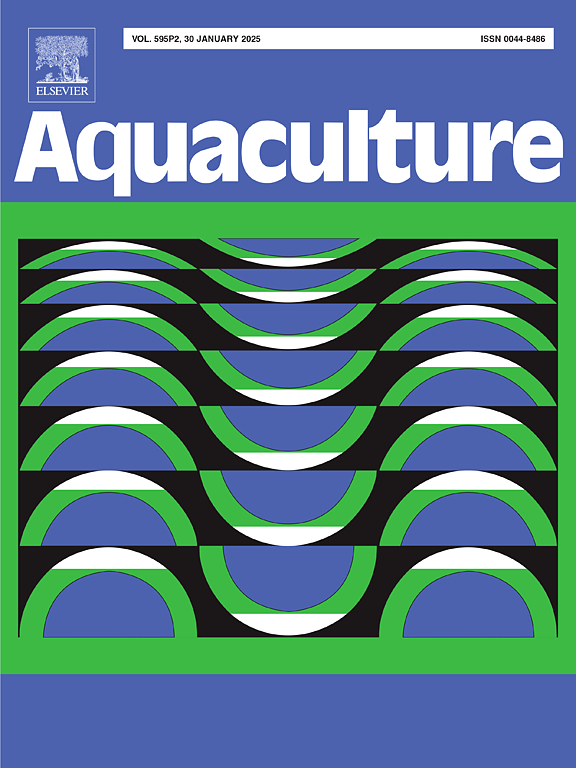stylirostri对虾(Litopenaeus stylirostris)种群经过36代驯化后的高残留加性遗传变异
IF 3.9
1区 农林科学
Q1 FISHERIES
引用次数: 0
摘要
一些养殖虾群是由极少数创始人驯化的,这可能限制了它们的遗传变异性,并加剧了近亲繁殖。新喀里多尼亚的太平洋蓝对虾(Litopenaeus stylirostris)种群就是这样一个例子。自1980年以来,它经历了驯化(本研究时为36代),但只有四位最初的创始人。通过部分RAD测序确定了用于家谱分配和遗传变异性评估的多态性snp。用820个SNP标记证实了该驯化群体与墨西哥野生参考群体相比遗传变异性较低。为了估计遗传参数,本研究首次将该方法应用于对虾遗传学研究,利用74条母虾和92条母虾的双父系受精方法,对每条母虾的全兄妹和半兄妹家族(n = 148)进行了选育。在6个月大(14.5 g)时,使用CIE L*a*b*颜色空间国际参考系统,通过数字视觉对1200只后代在烹饪前后的体重和外部颜色进行表型分析。这使得99.4%的后代能够成功地分配给具有171个SNP标记的父母。烹煮前后体重和颜色性状遗传力较高(h2 = 0.41 ~ 0.59)。生虾的蓝色(b*)与生体重呈负相关,但与零无显著差异(rg = - 0.25±0.24)。生对虾的蓝色(b*)值与熟对虾的红色(a*)值呈正相关(rg = 0.48±0.14)。所有的结果都有利于在新喀里多尼亚利用这个种群进行蓝虾的选择性繁殖计划,尽管它的初始创建者数量有限,驯化超过36代。讨论了可能影响结果的遗传因素。本文章由计算机程序翻译,如有差异,请以英文原文为准。
High residual additive genetic variability in a Pacific blue shrimp Litopenaeus stylirostris population after 36 generations of domestication from only 4 estimated founders
Some cultured shrimp populations have been domesticated from a very small number of founders, which likely limits their genetic variability and heightens inbreeding. The population of Pacific blue shrimp Litopenaeus stylirostris in New Caledonia is one such case. It has undergone domestication since 1980 (36 generations at the time of this study) but was based on only four initial founders. Polymorphic SNPs for pedigree assignment and assessment of genetic variability were identified by partial RAD sequencing. The low genetic variability of this domesticated population compared with a wild Mexican population of reference was confirmed with 820 SNP markers.
To estimate genetic parameters, full-sib and half-sib families (n = 148) were bred from 74 dams and 92 sires using a double-sire insemination of each dam with spermatophores from two sires, the first time that this method has been used in shrimp genetics. At 6 months of age (14.5 g), 1200 progenies were then phenotyped for body weight and external color by digital vision, before and after cooking, using the CIE L*a*b* color space international reference system. This allowed 99.4 % of the progenies were to be successfully assigned to parents with 171 SNP markers.
Heritability was high for body weight and color traits before and after cooking (h2 = 0.41–0.59). Correlations between the blue color (b*) of uncooked shrimps and uncooked body weight was negative but did not differ from zero (rg =−0.25 ± 0.24). The blue (b*) value of uncooked shrimps was positively correlated with the red (a*) value of cooked shrimps (rg = 0.48 ± 0.14).
All results are favorable to pursuing a selective breeding program for blue shrimp in New Caledonia using this population despite its limited number of initial founders and more than 36 generations of domestication. Genetic factors potentially contributing to the results are discussed.
求助全文
通过发布文献求助,成功后即可免费获取论文全文。
去求助
来源期刊

Aquaculture
农林科学-海洋与淡水生物学
CiteScore
8.60
自引率
17.80%
发文量
1246
审稿时长
56 days
期刊介绍:
Aquaculture is an international journal for the exploration, improvement and management of all freshwater and marine food resources. It publishes novel and innovative research of world-wide interest on farming of aquatic organisms, which includes finfish, mollusks, crustaceans and aquatic plants for human consumption. Research on ornamentals is not a focus of the Journal. Aquaculture only publishes papers with a clear relevance to improving aquaculture practices or a potential application.
 求助内容:
求助内容: 应助结果提醒方式:
应助结果提醒方式:


